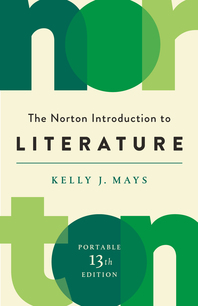
The Norton Introduction to Literature
Portable Thirteenth Edition
1 March 2020
Territory Rights — Worldwide including Canada, but excluding the British Commonwealth.
A DIVERSE COLLECTION OF VIBRANT CONTEMPORARY PIECES AND TEACHABLE CLASSICS
The Introduction to Literature’s varied selection allows students from diverse backgrounds to see themselves in the book’s pages. Highlights of the Thirteenth Edition include 29 new works, 21 by contemporary writers such as Tracy K. Smith, Terrance Hayes, A. E. Stallings, Joy Harjo and Ray Bradbury. These current voices join new classroom favourites, including works by Ralph Ellison, A.S. Byatt and Judith Ortiz Cofer.
A PROVEN APPROACH THAT HELPS STUDENTS HONE THEIR CRITICAL READING, WRITING AND ANALYSIS SKILLS
New Close Reading Workshops, 28 in total, are based on a proven approach developed at The University of Texas at Austin and give students step-by-step practice with literary analysis and writing skills. Each Close Reading Workshop focuses on a work in the anthology and guides students in how to observe, contextualise, analyse and create an argument based on a close reading of a text such as Edgar Allan Poe's "The Raven", Toni Morrison’s "Recitatif" and Lorraine Hansberry's A Raisin in the Sun. The workshops, many of which include audio, are easily assignable, with class reports that allow instructors to see how students' close reading skills improve over the course of the semester.
UNMATCHED SUPPORT FOR STUDENTS
The Norton Introduction to Literature provides students with comprehensive writing support in-text and online. The text features "Reading, Responding, Writing" genre openers, 15 examples of student writing and six Writing about Literature chapters that cover the entire arc of the writing process—from reading notes to the research paper. On Norton’s popular LitWeb site, students have access to eight Writing about Literature videos and Pause & Practice writing exercises that expand on those videos. Norton supports student readers with in-line glossing on every page of Hamlet, making Shakespeare more accessible and enjoyable. And a new combined glossary and index makes it easier for students to review key literary terms and find examples in the book.
UNMATCHED SUPPORT FOR INSTRUCTORS
The new Interactive Instructor’s Guide provides hundreds of resources in one searchable, sortable site to help teachers engage students and reduce the time required for course-prep. Additionally, all of Norton’s LitWeb activities and videos, plus customisable reading comprehension quizzes, can be easily incorporated into existing learning management systems. A Thematic Table of Contents gives instructors the flexibility to teach the course their way.
The Introduction to Literature’s varied selection allows students from diverse backgrounds to see themselves in the book’s pages. Highlights of the Thirteenth Edition include 29 new works, 21 by contemporary writers such as Tracy K. Smith, Terrance Hayes, A. E. Stallings, Joy Harjo and Ray Bradbury. These current voices join new classroom favourites, including works by Ralph Ellison, A.S. Byatt and Judith Ortiz Cofer.
A PROVEN APPROACH THAT HELPS STUDENTS HONE THEIR CRITICAL READING, WRITING AND ANALYSIS SKILLS
New Close Reading Workshops, 28 in total, are based on a proven approach developed at The University of Texas at Austin and give students step-by-step practice with literary analysis and writing skills. Each Close Reading Workshop focuses on a work in the anthology and guides students in how to observe, contextualise, analyse and create an argument based on a close reading of a text such as Edgar Allan Poe's "The Raven", Toni Morrison’s "Recitatif" and Lorraine Hansberry's A Raisin in the Sun. The workshops, many of which include audio, are easily assignable, with class reports that allow instructors to see how students' close reading skills improve over the course of the semester.
UNMATCHED SUPPORT FOR STUDENTS
The Norton Introduction to Literature provides students with comprehensive writing support in-text and online. The text features "Reading, Responding, Writing" genre openers, 15 examples of student writing and six Writing about Literature chapters that cover the entire arc of the writing process—from reading notes to the research paper. On Norton’s popular LitWeb site, students have access to eight Writing about Literature videos and Pause & Practice writing exercises that expand on those videos. Norton supports student readers with in-line glossing on every page of Hamlet, making Shakespeare more accessible and enjoyable. And a new combined glossary and index makes it easier for students to review key literary terms and find examples in the book.
UNMATCHED SUPPORT FOR INSTRUCTORS
The new Interactive Instructor’s Guide provides hundreds of resources in one searchable, sortable site to help teachers engage students and reduce the time required for course-prep. Additionally, all of Norton’s LitWeb activities and videos, plus customisable reading comprehension quizzes, can be easily incorporated into existing learning management systems. A Thematic Table of Contents gives instructors the flexibility to teach the course their way.


